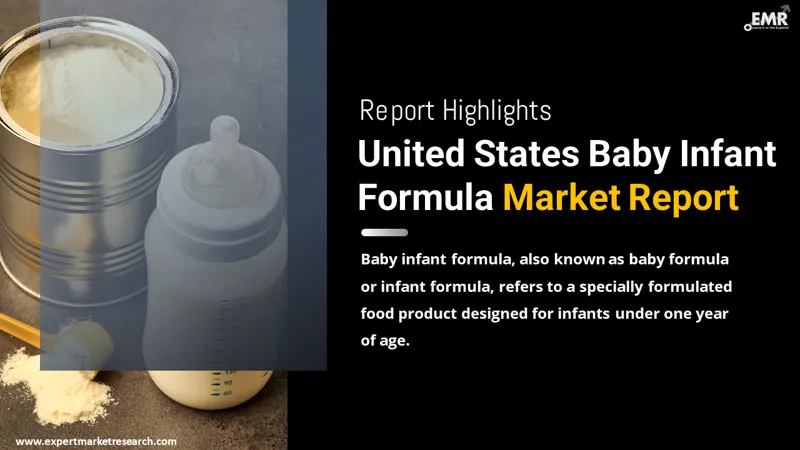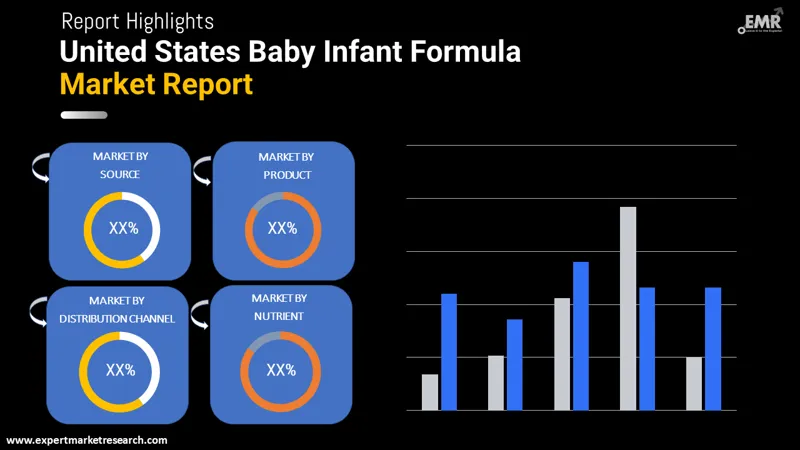
Consumer Insights
Uncover trends and behaviors shaping consumer choices today
Procurement Insights
Optimize your sourcing strategy with key market data
Industry Stats
Stay ahead with the latest trends and market analysis.
The United States baby infant formula market was valued at USD 6.29 Billion in 2025 and is expected to grow at a CAGR of 3.30%, reaching USD 8.70 Billion by 2035. The market growth is driven by increasing birth rates and growing demand for fortified infant nutrition products.
Base Year
Historical Period
Forecast Period
Compound Annual Growth Rate
3.3%
Value in USD Billion
2026-2035
*this image is indicative*
Baby infant formula or baby formula, or infant formula to a food product that is created especially for consumption by infants younger than one year of age. These formulas are designed to include all the necessary nutrients required by infants, acting as a suitable substitute for breast milk, with a nutritional profile resembling that of breast milk. Baby infant formula can be used as a replacement for breast milk or in supplementation, depending upon baby requirements and doctor recommendation.

Read more about this report - REQUEST FREE SAMPLE COPY IN PDF
The EMR’s report titled “United States Baby Infant Formula Market Report and Forecast 2026-2035” offers a detailed analysis of the market based on the following segments:
Market Breakup by Product
Market Breakup by Source
Market Breakup by Nutrient
Market Breakup by Distribution Channel
Market Breakup by Region

Read more about this report - REQUEST FREE SAMPLE COPY IN PDF
The infant milk segment by product is anticipated to account for a sizable share of the United States baby infant formula market. This can be attributed to its growing popularity as a nutritious and healthful substitute for breast milk as well as its superior convenience. Probiotics are added to different infant milks to prevent diarrhoea, soothe colic, and reduce the risk of allergies in the infants. As infants tend to feed frequently, parents often purchase compatible infant milks in larger volumes.
The comprehensive EMR report provides an in-depth assessment of the market based on the Porter's five forces model, along with giving a SWOT analysis. The report gives a detailed analysis of the following key players in the United States baby infant formula market, covering their competitive landscape and the latest developments like mergers, acquisitions, investments, and expansion plans.
Arla Foods amba, founded in 2000 and headquartered in Viby, Denmark, is a global food company that focuses on dairy. The company’s product line includes milk and milk powder, speciality cheese, milk-based beverages, cheese spread, yoghurt, butter, and spreads.
Nestlé S.A., established in 1866, is a Swiss multinational food and beverage processing corporation. Headquartered in Vevey, Switzerland, Nestle offers a wide range of products, including baby food, cereals, coffee, chilled and frozen food, dairy, drinks, and chocolate and confectionary.
*Please note that this is only a partial list; the complete list of key players is available in the full report. Additionally, the list of key players can be customized to better suit your needs.*
Other market players include Abbott Laboratories, Aussie Bubs, Inc., Bobbie Baby, Inc., Danone S.A., Else Nutrition Holdings Inc., Reckitt Benckiser Group PLC, Walmart Inc. (Parent’s Choice), Target Corporation (up & up), Walgreen Co. (Well Beginnings), and The Kroger Co. (Comforts For Baby), among others.




*While we strive to always give you current and accurate information, the numbers depicted on the website are indicative and may differ from the actual numbers in the main report. At Expert Market Research, we aim to bring you the latest insights and trends in the market. Using our analyses and forecasts, stakeholders can understand the market dynamics, navigate challenges, and capitalize on opportunities to make data-driven strategic decisions.*
Get in touch with us for a customized solution tailored to your unique requirements and save upto 35%!
The market is projected to grow at a CAGR of 3.30% between 2026 and 2035.
The major drivers of the market include the increasing number of working mothers, availability of specialised formulas, and growing awareness regarding the nutrition of baby infant formulas.
Rising cultural acceptance of baby formulas, increasing prevalence of specific nutritional needs among babies, use of baby infant formula to supplement breast milk, and popularity of devices to prepare bottles of baby infant formula are the key trends propelling the growth of the market.
The major regions in the market are New England, Mideast, Great Lakes, Plains, Southeast, Southwest, Rocky Mountain, and Far West.
The various products of baby infant formula in the market are infant milk, follow-on milk, speciality baby milk, and growing-up milk, among others.
The different sources of baby infant formula include regular, organic, milk with HMO, goat milk, and plant-based formula, among others.
The significant nutrients in the market for baby infant formula include carbohydrate, fat, protein, minerals, and vitamins, among others.
The major players in the United States baby infant formula market, according to the report, are Abbott Laboratories, Arla Foods amba, Aussie Bubs, Inc., Bobbie Baby, Inc., Danone S.A., Else Nutrition Holdings Inc., Reckitt Benckiser Group PLC, Nestlé S.A., Walmart Inc. (Parent’s Choice), Target Corporation (up & up), Walgreen Co. (Well Beginnings), and The Kroger Co. (Comforts For Baby), among others.
Explore our key highlights of the report and gain a concise overview of key findings, trends, and actionable insights that will empower your strategic decisions.
| REPORT FEATURES | DETAILS |
| Base Year | 2025 |
| Historical Period | 2019-2025 |
| Forecast Period | 2026-2035 |
| Scope of the Report |
Historical and Forecast Trends, Industry Drivers and Constraints, Historical and Forecast Market Analysis by Segment:
|
| Breakup by Product |
|
| Breakup by Source |
|
| Breakup by Nutrient |
|
| Breakup by Distribution Channel |
|
| Breakup by Region |
|
| Market Dynamics |
|
| Competitive Landscape |
|
| Companies Covered |
|
Datasheet
One User
USD 1,999
USD 1,799
tax inclusive*
Single User License
One User
USD 3,099
USD 2,789
tax inclusive*
Five User License
Five User
USD 4,599
USD 3,909
tax inclusive*
Corporate License
Unlimited Users
USD 5,999
USD 5,099
tax inclusive*
*Please note that the prices mentioned below are starting prices for each bundle type. Kindly contact our team for further details.*
Flash Bundle
Small Business Bundle
Growth Bundle
Enterprise Bundle
*Please note that the prices mentioned below are starting prices for each bundle type. Kindly contact our team for further details.*
Flash Bundle
Number of Reports: 3
20%
tax inclusive*
Small Business Bundle
Number of Reports: 5
25%
tax inclusive*
Growth Bundle
Number of Reports: 8
30%
tax inclusive*
Enterprise Bundle
Number of Reports: 10
35%
tax inclusive*
How To Order

Select License Type
Choose the right license for your needs and access rights.

Click on ‘Buy Now’
Add the report to your cart with one click and proceed to register.

Select Mode of Payment
Choose a payment option for a secure checkout. You will be redirected accordingly.
Gain insights to stay ahead and seize opportunities.

Get insights & trends for a competitive edge.

Track prices with detailed trend reports.

Analyse trade data for supply chain insights.

Leverage cost reports for smart savings

Enhance supply chain with partnerships.

Connect For More Information
Our expert team of analysts will offer full support and resolve any queries regarding the report, before and after the purchase.
Our expert team of analysts will offer full support and resolve any queries regarding the report, before and after the purchase.
We employ meticulous research methods, blending advanced analytics and expert insights to deliver accurate, actionable industry intelligence, staying ahead of competitors.
Our skilled analysts offer unparalleled competitive advantage with detailed insights on current and emerging markets, ensuring your strategic edge.
We offer an in-depth yet simplified presentation of industry insights and analysis to meet your specific requirements effectively.
Share